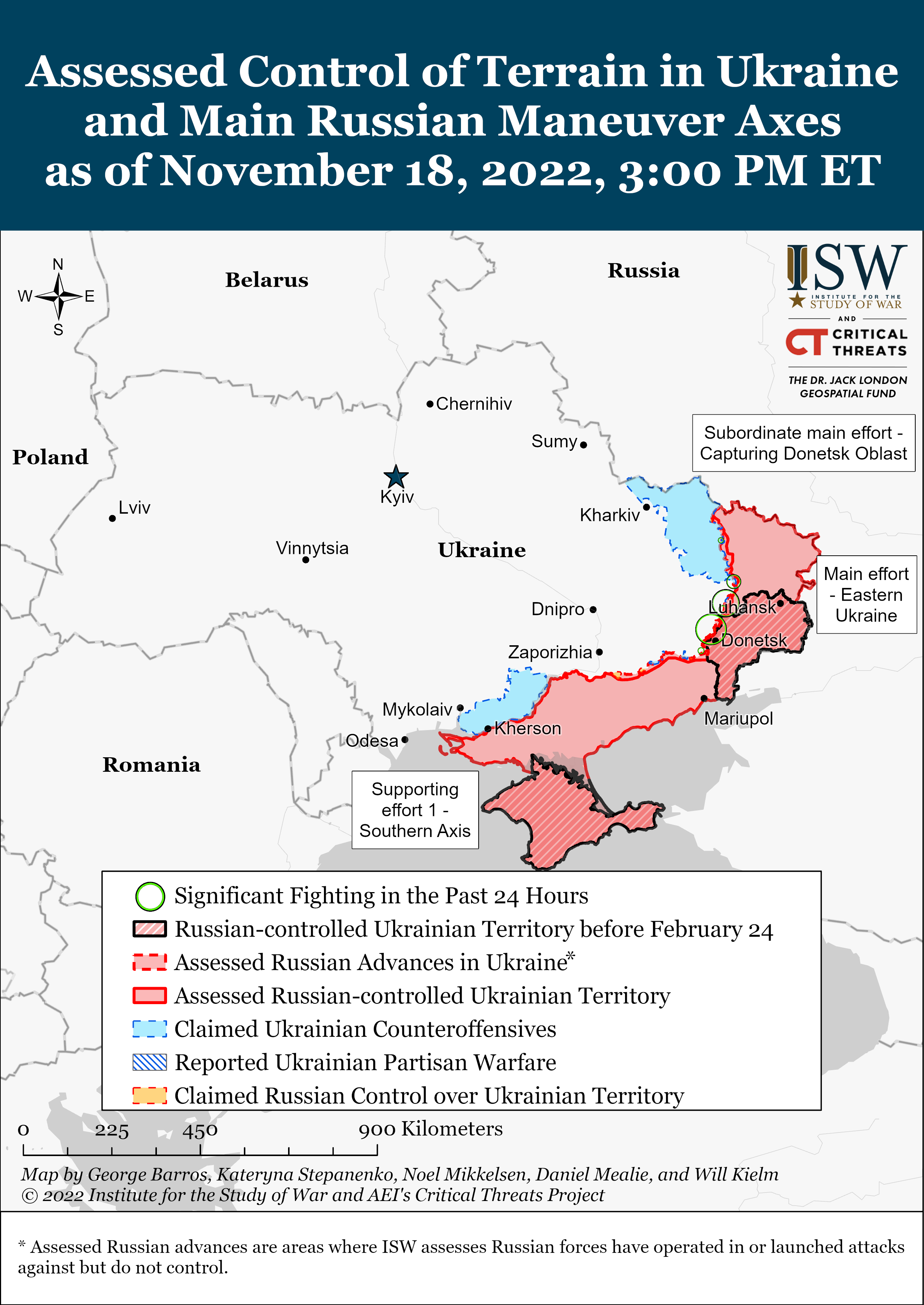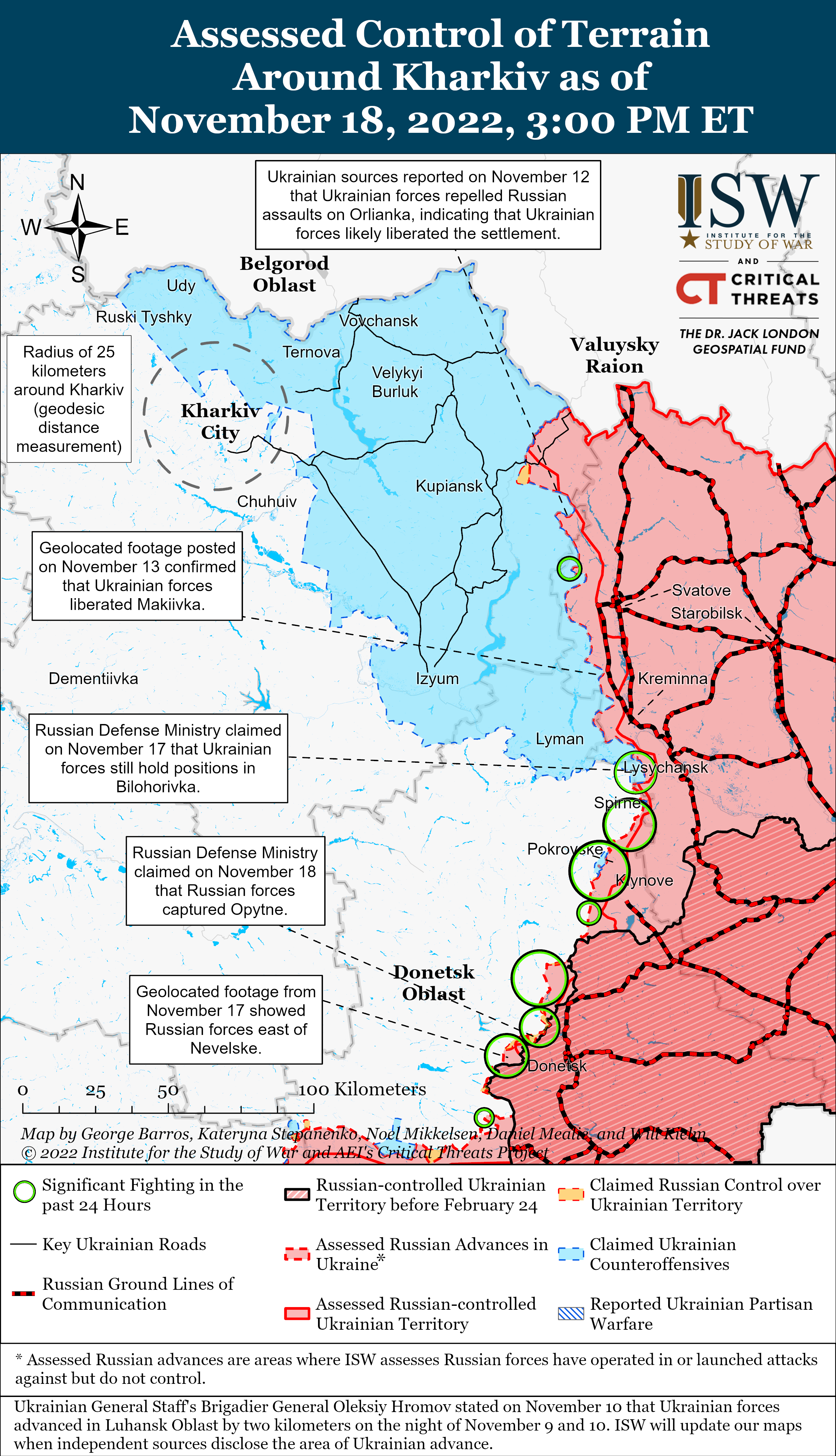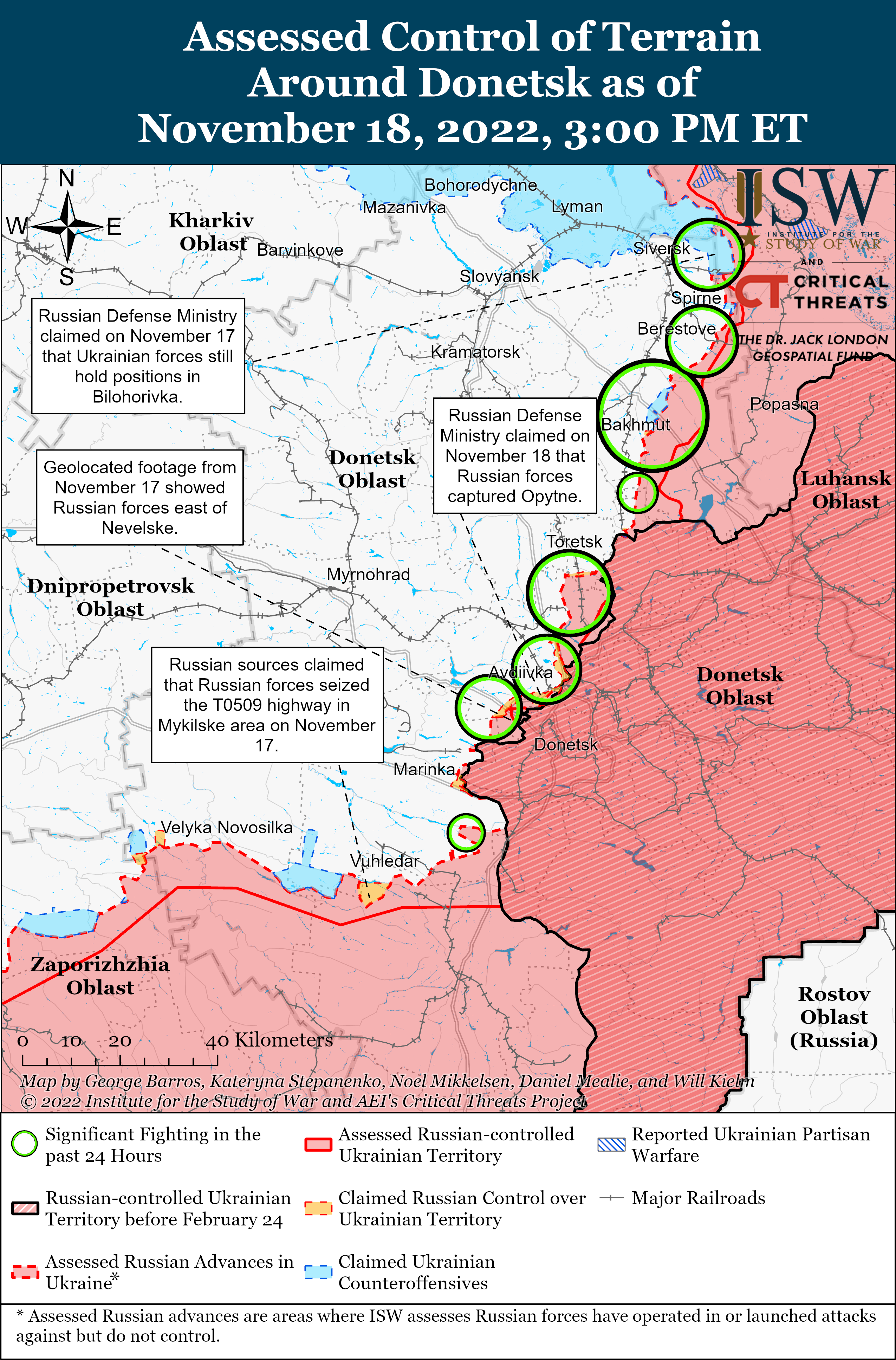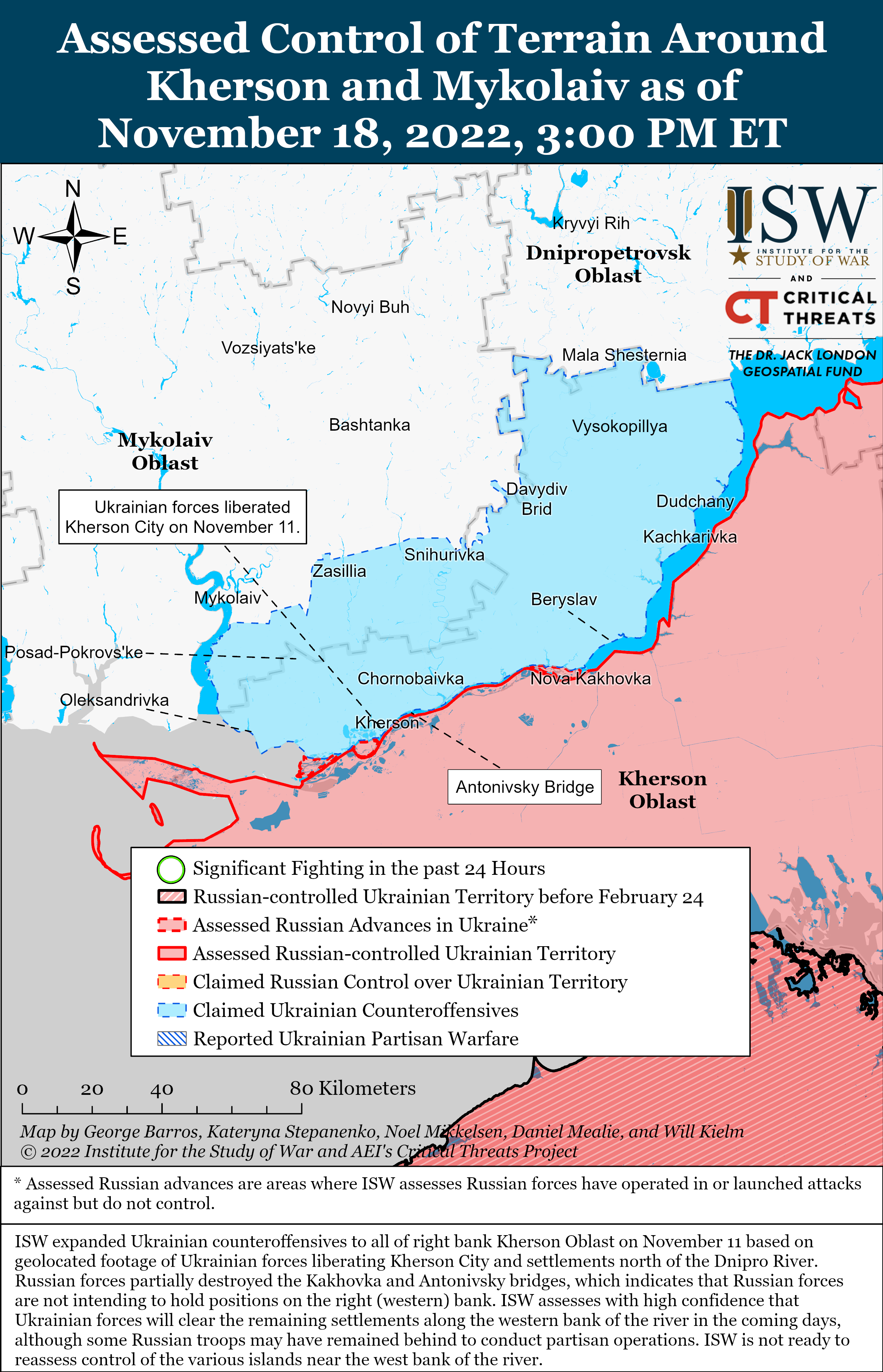https://twitter.com/DeuNachrichten/status/1593887469392769024/photo/1
---------------------------------------
( )


 The #Highlights of the SMO in #Ukraine for 18 Nov 2022
The #Highlights of the SMO in #Ukraine for 18 Nov 2022 by t.me/rybar
For the latest #UkraineWarNews #Report Excerps and some videos follow me!
Full #Reports and more:
t.me/sitreports
Join SITREP
by t.me/rybar
For the latest #UkraineWarNews #Report Excerps and some videos follow me!
Full #Reports and more:
t.me/sitreports
Join SITREP Map Reports - Top Videos - Analyses
Map Reports - Top Videos - Analyses #UkraineWarVideos https://twitter.com/i/status/1593841731841445890
--------------------
( ) NORD STREAM SABOTAGE: The Swedish Security Service has conclusively determined that the pipelines were sabotaged. Here’s how it was done. sakerhetspolisen.se/ovriga-sidor/o
-----------------------
ASSESSMENT
RUSSIAN OFFENSIVE CAMPAIGN, NOVEMBER 18, 2022
Karolina Hird, Grace Mappes, Madison Williams, Yekaterina Klepanchuk, and Frederick W. Kagan
November 18, 8:30pm ET
Click here to see ISW’s interactive map of the Russian invasion of Ukraine. This map is updated daily alongside the static maps present in this report.
Russian officials are preparing for further covert mobilization efforts even as the fall conscription cycle is underway, likely further flooding the already overburdened Russian force generation apparatus in such a way that will be detrimental to the development of mobilized and conscripted servicemen. Russian Telegram channels actively discussed indicators on November 18 that the Kremlin is preparing for a second mobilization wave and circulated an image of a draft summons received by a citizen of St. Petersburg who was reportedly told to appear for mobilization in January 2023 despite Russian President Vladimir Putin’s announcement of the formal end of partial mobilization on October 31.[1] Nationalist mil bloggers additionally circulated claims that general mobilization will begin in December or January.[2] An independent Russian outlet published an investigation on November 18 showing that state structures and enterprises are continuing to prepare their employees for mobilization by sending them to various training programs and mobilization-related educational courses.[3] Another Russian outlet noted that the Odintsovo garrison military court in Moscow Oblast inadvertently confirmed that mobilization is continuing despite its formal end.[4] The court reportedly accused a mobilized soldier of beating his commander on November 13 “during the performance of his duties of military service or in connection with the performance of these duties during the period of mobilization,” which indicates that the court is operating on the legal basis that mobilization is still very much underway.[5] The Kremlin has said that Russian President Vladimir Putin has no need to sign a decree formally ending the mobilization period, as ISW has previously reported.[6]
The continuation of covert mobilization efforts and potential preparations for another mobilization wave in tandem with the current fall conscription cycle is likely adding substantial strain to an already over-burdened Russian force generation apparatus. As ISW previously assessed, Putin likely ordered the end of partial mobilization in order to free up bureaucratic and administrative capacity for the November 1 conscription class.[7] However, it is evident that Russian authorities never fully halted mobilization efforts, which means that a limited number of mobilized recruits are still being forced through the training system at the same time as conscripts are going through their own training cycle. This will likely lead to even lower quality training for both mobilized recruits and conscripts as they compete for insufficient training capacity. Another wave of mobilization in the coming months will only worsen the situation and likely degrade the overall quality of the Russian troops that will be funneled to the frontline in Ukraine.
The International Atomic Energy Agency (IAEA) announced that it does not recognize the illegal Russian seizure and operation of the Zaporizhzhia Nuclear Power Plant (ZNPP) or the illegal annexation of occupied Ukrainian territory, a sharp escalation in IAEA rhetoric. The IAEA’s Board of Governors issued a statement on November 17 that called on Russia to “immediately abandon its baseless claims of ownership of the plant” and to withdraw “military and other personnel” from the ZNPP due to “grave concerns” over the ZNPP’s integrity.[8] The IAEA issued a statement on November 18 that Russian strikes on November 17 partially or completely cut power to Ukraine’s Khmelnytskyy Nuclear Power Plant and Rivne Nuclear Power Plant, and IAEA Director-General Rafael Grossi stated that these strikes demonstrate “the potential nuclear safety and security risks facing all of Ukraine’s nuclear facilities during this terrible war, not just the Zaporizhzhia Nuclear Power Plant.”[9] ISW recently assessed that the IAEA’s rhetorical shift suggests that Russian physical control and operational authority over the ZNPP alarms the IAEA.[10] Russian forces’ ongoing threats to both the ZNPP and Ukrainian nuclear power plants (NPPs) in unoccupied territory indicate that Russia is an unsuitable caretaker of the ZNPP, even though the Russian government relies on claims that it is a responsible operator of the ZNPP to legitimize its ongoing presence at the plant.[11]
Social media footage circulated on November 18 shows a Russian soldier opening fire on Ukrainians as other Russian soldiers were surrendering. The graphic footage shows Ukrainian troops in Makiivka, Luhansk Oblast, taking a group of Russian soldiers prisoner when one Russian soldier emerges from a house holding a gun and opens fire.[12] Drone footage shows the bodies of the deceased Russian soldiers after the incident.[13] Open-source analysts concluded that the Russian soldier opened fire initially, but it is unclear who killed the Russian prisoners, when, and under what circumstances.[14] However, the Russian information space immediately responded to the footage by widely accusing Ukrainian forces of a ”mass execution” of the Russian prisoners.[15] The Russian Investigative Committee opened a criminal case against Ukrainian Armed Forces and is reportedly trying to identify the Ukrainian servicemen in the video.[16]
Key Takeaways
- Russian officials are preparing for further covert mobilization efforts even as the fall conscription cycle is underway, likely further diminishing the development of quality mobilized and conscripted servicemen.
- The International Atomic Energy Agency (IAEA) announced that it does not recognize the illegal Russian seizure of the Zaporizhzhia Nuclear Power Plant (ZNPP) or the illegal annexation of other occupied Ukrainian territory, a sharp escalation in IAEA rhetoric.
- Social media footage circulated on November 18 shows a Russian soldier opening fire on Ukrainians as other Russian soldiers were surrendering.
- Russian forces reinforced rear areas in Luhansk Oblast and attempted to regain lost positions as Ukrainian troops continued counteroffensive operations along the Svatove-Kreminna line.
- Russian forces continued limited ground assaults near Bakhmut and Avdiivka and in western Donetsk Oblast.
- Russian occupation officials and military leadership are seemingly increasingly concerned about subsequent Ukrainian counteroffensive operations in southern Ukraine.
- Russia continues to face exceedingly low morale and poor discipline among its forces against the backdrop of ongoing domestic backlash to partial mobilization.
- Russian occupation officials and forces continued to intensify filtration measures in Russian-occupied territories in Ukraine and to undermine the Ukrainian national identity.
We do not report in detail on Russian war crimes because those activities are well-covered in Western media and do not directly affect the military operations we are assessing and forecasting. We will continue to evaluate and report on the effects of these criminal activities on the Ukrainian military and population and specifically on combat in Ukrainian urban areas. We utterly condemn these Russian violations of the laws of armed conflict, Geneva Conventions, and humanity even though we do not describe them in these reports.
- Ukrainian Counteroffensives—Eastern Ukraine
- Russian Main Effort—Eastern Ukraine (comprised of one subordinate and one supporting effort);
- Russian Subordinate Main Effort—Capture the entirety of Donetsk Oblast
- Russian Supporting Effort—Southern Axis
- Russian Mobilization and Force Generation Efforts
- Activities in Russian-occupied Areas
Ukrainian Counteroffensives (Ukrainian efforts to liberate Russian-occupied territories)
Eastern Ukraine: (Eastern Kharkiv Oblast-Western Luhansk Oblast)
Russian forces reinforced rear areas in Luhansk Oblast and attempted to regain lost positions as Ukrainian troops continued counteroffensive operations along the Svatove-Kreminna line on November 18. The Ukrainian General Staff noted that Russian forces freed up by the Russian retreat from the west (right) bank of Kherson Oblast transferred to Novoaidar, Luhansk Oblast, (55km southeast of Kreminna at the nexus of the T1306 Novoaidar-Severodonetsk and H21 Novoaidar-Starobilsk routes).[17] Ukrainian military sources also reported that Ukrainian troops repelled Russian attacks on Novoselivkse and Stelmakhivka, both within 13km northwest of Svatove.[18] Russian sources also claimed that Ukrainian troops attacked in this area toward Kuzemivka (13km northwest of Svatove).[19] Geolocated footage shows Ukrainian airborne troops destroying a Russian TOR-M2 surface-to-air missile complex in Daphne, 3km west of Svatove.[20] Russian sources claimed that Ukrainian troops unsuccessfully attacked Chervonopopivka (6km northwest of Kreminna) and are continuing attempts to attack southeast of Kreminna toward Lysychansk and Popasna.[21]
Russian Main Effort—Eastern Ukraine
Russian Subordinate Main Effort—Donetsk Oblast (Russian objective: Capture the entirety of Donetsk Oblast, the claimed territory of Russia’s proxies in Donbas)
Russian forces continued limited ground assaults near Bakhmut and Avdiivka and in western Donetsk Oblast on November 18. The Ukrainian General Staff reported that Ukrainian forces repelled Russian ground assaults northeast of Bakhmut near Spirne and Bilohorivka and south of Bakhmut near Opytne.[22] Luhansk People’s Republic (LNR) Deputy Interior Minister Vitaly Kiselyov claimed that Wagner Group forces repelled Ukrainian counterattacks on the southeastern outskirts of Bakhmut and near Opytne.[23] The Ukrainian General Staff reported that Ukrainian forces repelled Russian ground attacks southwest of Avdiivka near Pervomaiske and Vodyane, and southwest of Donetsk City near Novomykhailivka.[24] The Russian Ministry of Defense (MoD) claimed on November 17 that Russian forces captured Opytne (4 km southwest of Avdiivka), two days after the Donetsk People’s Republic (DNR) claimed that its forces captured the settlement.[25] ISW is currently unable to confirm these Russian territorial claims. Geolocated footage posted on November 17 shows that Russian forces made marginal gains advancing west toward Pervomaiske.[26] The Russian MoD claimed that Russian forces repelled Ukrainian ground attacks east of Vuhledar near Solodke, southeast of Vuhledar near Volodymyrivka, and southwest of Vuhledar near Pavlivka.[27]
Supporting Effort—Southern Axis (Russian objective: Maintain frontline positions and secure rear areas against Ukrainian strikes)
Note: ISW will report on activities in Kherson Oblast as part of the Southern Axis in this and subsequent updates. Ukraine’s counteroffensive in right-bank Kherson Oblast has accomplished its stated objectives, so ISW will not present a Southern Ukraine counteroffensive section until Ukrainian forces resume counteroffensives in southern Ukraine.
Russian forces continued to conduct defensive operations on the east (left) bank of the Dnipro River in Kherson Oblast on November 18. Ukraine’s Southern Operational Command reported that Russian forces continue to equip defensive lines and replenish their forces in eastern Kherson Oblast.[28] Ukraine’s Southern Operational Command also reported that Russian forces continue to draw further back from the eastern bank of the Dnipro River, forcibly relocating civilians from Novokiivka and transporting medical equipment from Nova Kakhovovka to Crimea.[29] The Ukrainian General Staff reported that Russian forces continued to strike areas on the western (right) bank of the Dnipro River, including Kherson City, Chornobaivka, Antonivka, and Beryslav.[30]
Ukrainian forces continued to strike Russian military assets and concentration areas south of the Dnipro River. The Ukrainian General Staff reported on November 18 that Ukrainian strikes in previous days killed over 50 Russian military personnel in Skadovsk and destroyed an ammunition depot in Chaplynka.[31] Ukraine’s Southern Operational Command stated that Ukrainian strikes destroyed military assets along the eastern bank of the river, including in Nova Kakhovka, Hola Prystan, and Oleshky.[32]
Russian occupation officials and military leadership are seemingly increasingly concerned about subsequent Ukrainian counteroffensive operations in southern Ukraine. The Ukrainian General Staff stated that Russian forces are accumulating engineering equipment to construct defensive lines in Mykhailivka Raion, Zaporizhia Oblast, (on the T0810 and T0818 highway intersection and connects Melitopol to the checkpoint at Vasylivka and Enerhodar) and are using production enterprises in Zaporizhia Oblast to construct more defensive structures.[33] Zaporizhia Oblast occupation official Vladimir Rogov stated that Russian officials are not preparing for a winter “lull” in hostilities in Zaporizhia Oblast.[34] Crimean occupation head Sergei Aksyonov announced on November 18 that Russian forces are building defensive lines in northern Crimea after satellite imagery emerged on November 10 of Russian defensive lines in the area.[35] As ISW has previously reported, Russian forces have increasingly relied on logistics lines through southern Ukraine, particularly connecting Melitopol to Crimea, to supply forces in southern Ukraine following the attack on the Kerch Strait Bridge.[36]
Russian forces continued routine fire against areas in Zaporizhia, Mykolaiv, and Dnipropetrovsk oblasts on November 18. Ukrainian official sources reported that Russian forces struck Zaporizhzhia City, Dnipro City, and Odesa City.[37] Ukrainian officials also reported that Russian forces shelled Nikopol and Marhanets, Dnipropetrovsk Oblast, and Ochakiv, Mykolaiv Oblast, just north of the Kinburn Spit.[38]
Mobilization and Force Generation Efforts (Russian objective: Expand combat power without conducting general mobilization)
Russia continues to face exceedingly low morale and poor discipline among its forces against the backdrop of ongoing domestic backlash to partial mobilization. A Russian source reported a case of drunken mobilized men engaging in a mass physical altercation at the Leninsky market in Omsk, Russia around November 6.[39] Footage posted on November 18 showed Russian conscripts complaining about being mismanaged.[40] A Russian source highlighted that Russian authorities continue to mobilize men with health problems and men originally promised deferments without explanation.[41] Citizens of St. Petersburg amplified Russian troops’ complaints of poor training, failing equipment, and mistreatment by demanding change and picketing in front of the Western Military District Headquarters in St. Petersburg.[42] A Russian media source reported that a Russian court ruled to block links to a popular petition against mobilization on Change.org that had over 500,000 signatures.[43] Another Russian source reported that Russian authorities forced college students to go to a military training camp in Dolgoprudny, Moscow Oblast, under the threat that they would not receive their diplomas otherwise.[44] The source stated that these students fear that Russian authorities will mobilize them after this training.[45] A Russian mil blogger criticized Russian authorities’ mismanagement of mobilization and failure to properly train and equip mobilized Russians as a “war crime.”[46]
Russian forces continued efforts to expand training capabilities and replenish diminishing supplies. The Russian MoD shared multiple reports on November 17 of mobilized Russian troops training at centers in Buryatia Republic, Kaliningrad Oblast, and Novosibirsk Oblast.[47] The Russian MoD emphasized that experienced instructors are training mobilized men in various combat skills including weapons training, hand-to-hand combat, operating drones, and first aid.[48] The Russian MoD is likely presenting these reports in a continued attempt to quell public dissatisfaction with the level of training mobilized servicemen are receiving. A Russian source reported on November 18 that Russian forces began to receive Iranian-made flak jackets and helmets, which is consistent with previous reports that Russian forces are relying on foreign-provided weapons and armor due to a shortage of domestic supply.[49] Multiple Russian sources reported that the Russian public has had to supplement Russian supply shortages with their own contributions.[50]
Russian occupation authorities continued forced mobilization efforts in Ukrainian temporarily occupied territories on November 18. The Ukrainian General Staff and the Luhansk Oblast Administration reported that the Russian Ministry of Health ordered healthcare workers in Luhansk Oblast to register for military service to fill staffing vacancies because Russian losses have greatly strained the Russian occupation medical network.[51] Melitopol Mayor Ivan Fedorov also confirmed reports that Russian occupation officials plan to forcibly mobilize Russian passport holders in the southern occupied territories into the Russian forces.[52]
Activity in Russian-occupied Areas (Russian objective: consolidate administrative control of occupied and annexed areas; forcibly integrate Ukrainian civilians into Russian sociocultural, economic, military, and governance systems)
Russian occupation officials and forces continued to intensify filtration measures in Russian-occupied territories in Ukraine on November 18. The Ukrainian Resistance Center reported that occupation officials evacuated local residents suspected of pro-Ukrainian activities in Mykhailivka, Zaporizhia Oblast, and sent them to Tymoshivka, Zaporizhia Oblast with the aid of local collaborators.[53] Multiple Ukrainian sources reported that Russian forces forcibly evacuated residents of Novokyivka, Kherson Oblast.[54] The Ukrainian Resistance Center reported that Russian doctors examined Ukrainian children and sent them to Russia for treatment.[55] The Ukrainian Zaporizhia Oblast Military Administration reported that Russian officials evacuated 170 people, including 37 children, from Zaporizhia Oblast in one day.[56] Sevastopol Occupation Governor Mikhail Razvozhaev reported that 79 evacuated residents from Kherson Oblast arrived in Sevastopol, Crimea, and stated that Crimean officials are organizing appropriate documentation for them.[57]
Russian occupation officials continued efforts to undermine the Ukrainian national identity. The Luhansk Oblast Administration reported that occupation officials appointed a Russian citizen from Novosibirsk, Novosibirsk Oblast, as director of a secondary school in Novooleskandrivka, Luhansk Oblast, and that occupation official forced Ukrainian civil servants to sign documents renouncing their Ukrainian citizenship.[58] The Ukrainian Resistance Center reported that occupation officials held school events to teach Ukrainian children how to detect pro-Ukrainian residents and how to notify Russian occupation officials about them.[59] The Center clarified that so far, Ukrainian children are not yet going to officials to inform them about pro-Ukrainian activities and are only telling their parents.
Russian occupation officials continued to face difficulties dealing with wounded Russian forces in occupied Ukrainian territory on November 18. The Ukrainian Resistance Center reported that occupation officials brought in Russian doctors and medical interns to the occupied territories because Ukrainian residents refused to provide medical services to Russian soldiers and the number of wounded Russian forces is increasing.[60] Ukrainian Melitopol Mayor Ivan Fedorov amplified reports from recent days that Russian occupation officials are attempting to collect blood from Ukrainian residents for wounded Russian forces.[61] Fedorov reiterated that occupation officials are expelling Ukrainian residents from the Melitopol hospital inpatient unit to free upwards for wounded Russian forces.[62]
Note: ISW does not receive any classified material from any source, uses only publicly available information, and draws extensively on Russian, Ukrainian, and Western reporting and social media as well as commercially available satellite imagery and other geospatial data as the basis for these reports. References to all sources used are provided in the endnotes of each update.
References
[1] https://t.me/mozhemobyasnit/14087; https://t.me/m0sc0wcalling/14687
[2] https://t.me/astrapress/16020; https://t.me/Bratchuk_Sergey/22951
[3] https://poligonmedia dot io/gosstruktury-prodolzhayut-gotovit-k-mobilizaczii/
[4] https://pravo.ru/news/243908/
[5] https://pravo dot ru/news/243908/ ; https://t.me/vchkogpu/34387; https://t.me/terzdrsm/17406
[6] https://understandingwar.org/backgrounder/russian-offensive-campaign-ass... https://www.reuters.com/world/europe/kremlin-no-decree-needed-end-partia...
[7] https://understandingwar.org/backgrounder/russian-offensive-campaign-ass...
[8] https://www.iaea.org/sites/default/files/22/11/gov2022-71.pdf
[9] https://www.iaea.org/newscenter/pressreleases/update-127-iaea-director-g...
[10] https://understandingwar.org/backgrounder/russian-offensive-campaign-ass...
[11] https://www.interfax dot ru/world/826989; https://understandingwar.org/backgrounder/warning-update-russia-may-cond... https://www.understandingwar.org/backgrounder/russian-offensive-campaign...
[12] GRAPHIC: https://twitter.com/666_mancer/status/1593502500962779136?s=20&t=AFtGE1n... reddit.com/r/CombatFootage/comments/yy62hy/ukrainians_were_taking_a_group_of_russians/
[13] GRAPHIC: https://twitter.com/Militarylandnet/status/1593529572422729728?s=20&t=_k...
[14] https://twitter.com/666_mancer/status/1593502500962779136?s=20&t=AFtGE1n... https://twitter.com/Militarylandnet/status/1593529572422729728?s=20&t=_k...
[15] https://t.me/NeoficialniyBeZsonoV/19906 ; https://t.me/rybar/41277; h...
[16] https://t.me/sledcom_press/4114
[17] https://www.facebook.com/GeneralStaff.ua/posts/pfbid02i6fqxP5a5aeQggdJAJ...
[18] https://www.facebook.com/GeneralStaff.ua/posts/pfbid0qTnt917CXPiDi2Fx69m...
[19] https://t.me/rybar/41282; https://t.me/wargonzo/9317
[20] https://www.facebook.com/igor.sydorenko.90/posts/pfbid02upwSaL3XDRfacyCT... https://twitter.com/neonhandrail/status/1593478289875963904?s=20&t=stQpW...
[21] https://twitter.com/RALee85/status/1593351630589657092?s=20&t=yoN8XLbxFy...
[22] https://www.facebook.com/GeneralStaff.ua/posts/pfbid0qTnt917CXPiDi2Fx69m...
[23] https://t.me/kommunist/13325
[24] https://www.facebook.com/GeneralStaff.ua/posts/pfbid0qTnt917CXPiDi2Fx69m...
[25] https://t.me/TRO_DPR/9699; https://t.me/TRO_DPR/9698; https://t.me/mod_russia/21837
[26] https://twitter.com/GeoConfirmed/status/1593614535029653504?s=20&t=7xjEj... https://twitter.com/rybar_en/status/1593110795189379072?s=20&t=7xjEjn1-9...
[27] https://t.me/mod_russia/21837
[28] https://www.facebook.com/watch/?v=872774777058590; https://www.facebook.com/watch/?v=1295309867911590
[29] https://www.facebook.com/watch/?v=1295309867911590
[30] https://www.facebook.com/GeneralStaff.ua/posts/pfbid02i6fqxP5a5aeQggdJAJ...
[31] https://www.facebook.com/GeneralStaff.ua/posts/pfbid02i6fqxP5a5aeQggdJAJ...
[32] https://www.facebook.com/watch/?v=1295309867911590; https://t.me/operat... https://www.facebook.com/watch/?v=1295309867911590
[33] https://www.facebook.com/GeneralStaff.ua/posts/pfbid02i6fqxP5a5aeQggdJAJ...
[35] https://t.me/stranaua/75876 https://t.me/stranaua/74417
[36] https://www.understandingwar.org/backgrounder/russian-offensive-campaign...
[37] https://t.me/stranaua/75848; https://www.facebook.com/GeneralStaff.ua/p...
[38] https://www.facebook.com/GeneralStaff.ua/posts/pfbid0qTnt917CXPiDi2Fx69m... https://t.me/Yevtushenko_E/1448 ; https://t.me/vilkul/2269 ; https://t.me/dnipropetrovskaODA/2465
[39] https://t.me/omsk_ogo/10480 ; https://t.me/omsk_ogo/10401
[40] https://twitter.com/NOELreports/status/1593556893582217219?s=20&t=AFtGE1...
[41] https://t.me/tmn_bgregion72/4391; https://t.me/svobodnieslova/931; https://t.me/iv?url=https://verstka.media/federalnye-smi-ne-poluchili-br...
[42] https://t.me/ostorozhno_novosti/12723; https://t.me/newsholod/2305
[43] . https://www.dovod dot online/sud-vo-vladimire-postanovil-zablokirovat-peticiju-protiv-mobilizacii/ ; https://leninsky--wld.sudrf dot ru/modules.php?name=sud_delo&srv_num=1&name_op=doc&number=117787023&delo_id=41&new=0&text_number=1
[44] https://t.me/ostorozhno_moskva/2374
[45] https://t.me/ostorozhno_moskva/2374
[46] https://t.me/rybar/41300; https://t.me/rybar/41298
[47] https://t.me/mod_russia/21806; https://t.me/mod_russia/21810; https://...
[48] https://t.me/mod_russia/21806; https://t.me/mod_russia/21820; https://...
[49] https://t.me/mobilizationnews/4148; https://twitter.com/wartranslated/s...
[50] https://t.me/mobilizationnews/4137; https://t.me/sibirmedia/23997; htt...
[51] https://www.facebook.com/GeneralStaff.ua/posts/pfbid0qTnt917CXPiDi2Fx69m...
[52] https://t.me/ivan_fedorov_melitopol/898
[53] https://sprotyv dot mod.gov.ua/2022/11/18/okupanty-vyvezly-proukrayinskyh-meshkancziv-odnogo-zi-smt-zaporizhzhya/
[54] https://t.me/hueviyherson/29306 ; https://suspilne dot media/319414-rosijski-okupanti-primusovo-evakuuvali-ziteliv-novokiivki-na-hersonsini/
[55] https://sprotyv.mod.gov dot ua/2022/11/18/rosiyany-zvozyat-na-tot-interniv-cherez-brak-likariv/
[56] https://t.me/zoda_gov_ua/14801
[57] https://t.me/razvozhaev/1452 ; https://t.me/razvozhaev/1462
[58] https://t.me/luhanskaVTSA/6923
[59] https://sprotyv.mod.gov dot ua/2022/11/18/na-luganshhyni-okupanty-zaklykayut-shkolyariv-zdavaty-proukrayinskyh-meshkancziv
[60] https://sprotyv.mod.gov dot ua/2022/11/18/rosiyany-zvozyat-na-tot-interniv-cherez-brak-likariv/
[61] https://t.me/ivan_fedorov_melitopol/900 ; https://t.me/ivan_fedorov_me...
[62] https://t.me/ivan_fedorov_melitopol/900 ; https://t.me/ivan_fedorov_me...









